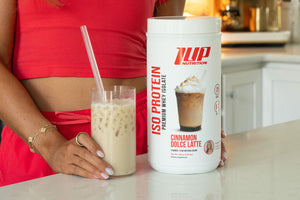What is the IIFYM Diet?
IIFYM stands for “if it fits your macros.”
The concept originated on bodybuilding message boards as a result of aspiring bodybuilders and dedicated fitness enthusiasts growing tired of eating the same old, same old bland, “clean” foods.
When said individual could no longer choke down another plate of boiled chicken, rice, and broccoli, they’d create a thread in the forum and ask, “is it ok if I eat ‘X’ food, or will it ruin my progress in the gym?”
The more educated members of the boards would respond with something along the lines of “yes, as long as it fits your macros.”
Over time, these sort of questions became more and more numerous, such that the responses became shorter and shorter until “if it fits your macros” was abbreviated to IIFYM.
The “diet” holds that so long as you hit your macro (macronutrient) goals, you can eat basically whatever you want and still see progress, be it weight loss, muscle gain, or body recomposition.
You probably think this sounds too good to be true.
But the truth is that calories really are the driver behind weight loss and weight gain.
In other words, if you consume fewer calories than your body needs, you will lose weight.
Conversely, if you consume more calories than your body needs, then you will gain weight.
It’s simple thermodynamics.
Now, how you choose to divide those calories does become important if you’re looking to maximize performance and appearance, which is where macros enter the picture.
What Foods Can I Eat on IIFYM?
According to the principles of IIFYM, you can eat whatever food you want (pizza, beer, chips, chicken breast, bananas, etc.) so long as it fits your macros.
As a general rule, the less refined a food is, and/or the less it’s removed from its original state, the healthier the food is.
Keep in mind, though, that this is a general rule.
Why Follow IIFYM Diet?
Millions of individuals have lost weight following the traditional “bodybuilder’s diet” of chicken breast, egg whites, cottage cheese, rice, and broccoli over the years. And, a great many of those same individuals have also been miserable while achieving the desired body composition results
IIFYM showed the masses that you don’t have to completely hate your diet, or give up the foods you love, in order to get the results you want.
No longer are you forced to eat the same 6-8 bland foods day in and day out. You can certainly eat those foods (if you enjoy them), but you can also have other delicious foods as well and not derail your results...so long as you stay within the confines of your macro goals.
How Do I Follow the IIFYM Diet?
Unlike many of the other popular fat loss fad diets over the years, the IIFYM diet is pretty simple to follow and doesn’t place any restrictions on what foods you can or cannot eat. So long as you hit your macro targets (and subsequently stay within your calorie limits), anything is fair game.
To follow the IIFYM diet, you first need to calculate your macros.
In order to calculate your macros, you need to know how many calories you need to eat each day in order to reach your goal (fat loss, muscle gain, etc.).
If you need help figuring out how many calories you need to eat to lose weight or build muscle, click here.
Once you have the total number of calories you need to eat per day, then you need to figure out how to divvy up those calories across the various macronutrients.
In total, there are four macronutrients (macros) that we need to be concerned with:
- Protein, which contains 4 calories per gram.
- Carbohydrates, which contain 4 calories per gram.
- Fat, which contains 9 calories per gram.
- Alcohol, which contains 7 calories per gram
We first set protein, as that is the most important macronutrient in terms of maximizing body composition since it provides the building blocks (amino acids) your body needs to build and repair muscle tissue as well as protect against muscle breakdown when dieting.
Typically, protein is set between 0.8-1 grams per pound of bodyweight.
So, if you weigh 150 pounds, you would consume between 120-150 grams of protein per day. Ideally, you would space this amount out across 3-5 meals, depending on your schedule and dietary preference, but hitting this number is more important than at what time of day you eat it.
Next, we set fat.
Generally speaking, fat is set between 0.3-0.5 grams per pound.
Using the example bodyweight of 150lbs, this means you would consume between 45-75 grams of fat each day.
This leaves us with only carbohydrates to determine.
In order to figure out how many carbohydrates you can consume each day, you subtract the protein and fat calories from your total daily calorie needs and then divide by four (since each gram of carbohydrate contains four calories).
To better explain this, let’s continue with our example 150-pound gym rat.
Thus far, he/she needs to eat 150 grams of protein and 50 grams of fat per day.
This gives:
Calories from protein: 150 * 4 = 600 calories
Calories from fat: 50 * 9 = 450 calories
Now, we add the calories from protein and fat and subtract it from the daily total.
Plugging height, weight, activity level, and age of our imaginary lifter into a TDEE calculator, we get a total daily calorie intake of 2000 calories.
Subtracting out the protein and fat calories from the 2000-calorie diet gives:
2000 - 600 - 450 = 950 calories which are allocated to carbohydrates
Carbohydrate macros: 950 / 4 = 237.5 grams of carbohydrates
So, in our example, our gym rat would aim to consume:
- 150 grams of protein
- 50 grams of dietary fat
- ~237 grams of carbohydrate
Now, as you likely noticed, we gave a range up top for both protein and fat. And, it’s here we set yet another great benefit of the IIFYM diet -- it’s highly customizable.
Let’s say that you personally enjoy eating more dietary fat and less carbohydrates. You can simply increase the amount of fat you eat and reduce the amount of carbohydrates you eat each day.
Cons of the IIFYM Diet
As flexible and easy-to-follow as IIFYM seems to be, it’s not without its faults, or rather, individuals who improperly utilize its core principles.
Somewhere along the way the fundamentals of the IIFYM diet were misconstrued, and instead of following a primarily nutrient-dense diet, IIFYMers started to see how much cake, cookies, pizza, and ice cream they could “get away with” without adversely impacting their results.
If you’re active on social media, you’ve likely seen these debaucherous bacchanals involving whole days of gorging on nothing but pop tarts, chicken wings, and ice cream, because after all “it fits my macros.”
In reality, this is a gross bastardization of IIFYM.
The point of the diet isn’t to see how many frankenfoods you can stuff into your daily diet. The point is to help people avoid developing complexes or unhealthy relationships with supposedly “bad” foods.
Another shortcoming of the IIFYM diet is that it may not place a strong enough emphasis on one’s micronutrient intake. Since a person can “technically” eat whatever they want so long as they hit their macros, it is theoretically possible a person could develop nutrient deficiencies.
But, if you refer to the previous point we just made, IIFYM isn’t an excuse to gorge on junk food. It is to allow an individual the flexibility to eat higher calorie foods without having to stress that they’ve committed a cardinal dieting sin by having a bite of cake.
Still, following an IIFYM diet could lead to the development of eating disorders as individuals become so focused on meticulously tracking their food intake (so that they can “fit” in junk food) that they may not feel ok eating foods that they cannot religiously track the breakdown of carbs, protein, and fat.[3]
The Bottom Line on the IIFYM Diet
The IIFYM diet is a flexible dieting method for individuals who want to lose fat or build muscle mass without feeling overly restricted or confined to a short list of “clean” or “approved” foods.
Since any food (or drink) is allowed on the IIFYM diet, many people find it easier and more enjoyable to follow than other diets. Remember, compliance and sustainability are two major factors in determining the success of any diet.
One shortcoming of the IIFYM diet is that it does not focus on tracking micronutrients.
However, if you abide by the founding principles of the IIFYM diet (~80% of your daily diet should come from minimally processed, micronutrient-dense foods), then you shouldn’t need to micromanage your micronutrient intake as you will be eating a diverse, well-rounded diet.
Overall, if you enjoy being able to call your own shots and can be diligent with your tracking (as well as your daily nutrition choices), the IIFYM diet is one of the better nutrition protocols to follow.
References
- Chai, W. Liebman, M. (2005), Effect of different cooking methods on vegetable oxalate content. Journal of Agriculture and Food Chemistry 53, 3027–3030.
- Dewanto, V., Wu, X., Adom, K. K., & Liu, R. H. (2002). Thermal processing enhances the nutritional value of tomatoes by increasing total antioxidant activity. Journal of Agricultural and Food Chemistry, 50(10), 3010–3014. https://doi.org/10.1021/jf0115589
- Levinson CA, Fewell L, Brosof LC. My Fitness Pal calorie tracker usage in the eating disorders. Eat Behav. 2017;27:14–16. doi:10.1016/j.eatbeh.2017.08.003






